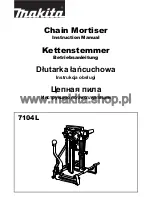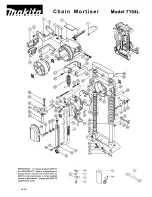
13
29.
Select saw blades in relation to the material to be
cut.
30.
Take care when slotting.
31.
Replace the kerf board when worn.
32.
Do not use saw blades manufactured from high
speed steel.
33.
Some dust created from operation contains
chemicals known to cause cancer, birth defects or
other reproductive harm. Some examples of these
chemicals are:
• lead from lead-based-painted material and,
• arsenic and chromium from chemically-treated
lumber.
Your risk from these exposures varies,
depending on how often you do this type of
work. To reduce your exposure to these
chemicals: work in a well ventilated area and
work with approved safety equipment, such as
those dust masks that are specially designed to
filter out microscopic particles.
34.
To reduce the emitted noise, always be sure that
the blade is sharp and clean.
35.
The operator is adequately trained in the use,
adjustment and operation of the machine.
36.
Use correctly sharpened saw blades. Observe the
maximum speed marked on the saw blade.
37.
Refrain from removing any cut-offs or other parts
of the workpiece from the cutting area whilst the
tool is running and the saw head is not in the rest
position.
38.
Use only saw blades recommended by the
manufacturer which conform to EN847-1.
39.
Wear gloves for handling saw blade (saw blades
shall be carried in a holder wherever practicable)
and rough material.
40.
When fitted with laser, no exchange with different
type of laser is permitted. Repairs shall only be
carried out correctly.
SAVE THESE INSTRUCTIONS.
INSTALLATION
Bench mounting (Fig. 1)
When the tool is shipped, the handle is locked in the
lowered position by the stopper pin. Release the stopper
pin by simultaneously applying a slight downward
pressure on the handle and pulling the stopper pin.
WARNING:
•
Ensure that the tool will not move on the
supporting surface.
Movement of the miter saw on
the supporting surface while cutting may result in loss
of control and serious personal injury.
(Fig. 2)
This tool should be bolted with four bolts to a level and
stable surface using the bolt holes provided in the tool’s
base. This will help prevent tipping and possible injury.
FUNCTIONAL DESCRIPTION
WARNING:
•
Always be sure that the tool is switched off and
unplugged before adjusting or checking function
on the tool.
Failure to switch off and unplug the tool
may result in serious personal injury from accidental
start-up.
Blade guard (Fig. 3)
When lowering the handle, the blade guard rises
automatically. The blade guard returns to its original
position when the cut is completed and the handle is
raised.
WARNING:
•
Never defeat or remove the blade guard or the
spring which attaches to the guard.
An exposed
blade as a result of defeated guarding may result in
serious personal injury during operation.
In the interest of your personal safety, always maintain the
blade guard in good condition. Any irregular operation of
the blade guard should be corrected immediately. Check
to assure spring loaded return action of guard.
WARNING:
•
Never use the tool if the blade guard or spring are
damaged, faulty or removed.
Operation of the tool
with a damaged, faulty or removed guard may result in
serious personal injury.
If the see-through blade guard becomes dirty, or sawdust
adheres to it in such a way that the blade and/or
workpiece is no longer easily visible, unplug the saw and
clean the guard carefully with a damp cloth. Do not use
solvents or any petroleum-based cleaners on the plastic
guard because this may cause damage to the guard.
If the blade guard becomes dirty and needs to be cleaned
for proper operation follow the steps below:
With the tool switched off and unplugged, use the
supplied socket wrench to loosen the hex bolt holding the
center cover. Loosen the hex bolt by turning it
counterclockwise and raise the blade guard and center
cover.
(Fig. 4)
With the blade guard so positioned, cleaning can be more
completely and efficiently accomplished. When cleaning
is complete reverse procedure above and secure bolt. Do
not remove spring holding blade guard. If guard becomes
damaged through age or UV light exposure, contact a
Makita service center for a new guard.
DO NOT DEFEAT
OR REMOVE GUARD.
Positioning kerf board (Fig. 5 & 6)
This tool is provided with the kerf boards in the turn base
to minimize tearing on the exit side of a cut. The kerf
boards are factory adjusted so that the saw blade does
not contact the kerf boards. Before use, adjust the kerf
boards as follows:
First, unplug the tool. Loosen all the screws (3 each on left
and right) securing the kerf boards. Re-tighten them only
to the extent that the kerf boards can still be easily moved
by hand. Lower the handle fully and push in the stopper
pin to lock the handle in the lowered position. Loosen the
screw which secures the slide poles. Pull the carriage
toward you fully. Adjust the kerf boards so that the kerf
boards just contact the sides of the blade teeth. Tighten
the front screws (do not tighten firmly). Push the carriage
toward the guide fence fully and adjust the kerf boards so
that the kerf boards just contact the sides of blade teeth.
Tighten the rear screws (do not tighten firmly).
Summary of Contents for LS1017
Page 2: ...2 1 2 3 4 5 6 7 8 1 2 2 3 3 4 5 6 7 4 8 9 10 11 13 12 14 ...
Page 3: ...3 9 10 11 12 13 14 15 16 15 16 17 18 19 20 21 21 22 18 23 21 18 24 23 25 26 21 27 28 ...
Page 4: ...4 17 18 19 20 21 22 23 24 26 27 28 29 30 31 32 33 1 34 35 36 37 3 ...
Page 6: ...6 33 34 35 36 37 38 51 52 53 5 14 54 55 52 56 25 57 ...
Page 8: ...8 47 48 49 50 51 52 53 54 14 69 20 14 70 5 18 17 21 22 71 72 70 6 12 5 18 23 ...
Page 9: ...9 55 56 57 73 72 74 75 ...
Page 119: ...119 ...
Page 120: ...ALA Makita Corporation Anjo Aichi Japan JM2318A026 www makita com ...














































